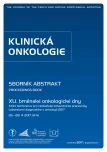Molecular Pathology of Colorectal Cancer, Microsatellite Instability – the Detection, the Relationship to the Pathophysiology and Prognosis
Authors:
V. Brychtová 1; R. Šefr 2; R. Hrstka 1; P. Vídeňská 3; B. Bencsiková 1; B. Hanáková 1; L. Zdražilová Dubská 1; R. Nenutil 1; E. Budinská 1
Authors‘ workplace:
RECAMO, Masarykův onkologický ústav, Brno
1; Klinika operační onkologie, Masarykův onkologický ústav, Brno
2; Centrum pro výzkum toxických látek v prostředí, PřF MU, Brno
3
Published in:
Klin Onkol 2017; 30(Supplementum1): 153-155
Category:
Article
Overview
Background:
Colorectal carcinoma (CRC) is third most common cancer worldwide with very heterogenous character. In most cases, it is caused by sporadic events leading to disruption of epithelial cells of the colon. The minority evolves from germline mutations associated with hereditary cancer syndromes. Mechanisms leading to mutations of oncogenes, tumour suppressors and genes of DNA repair mechanisms include: 1. chromosomal instability, 2. microsatellite instability and 3. CpG island methylator phenotype. Microsatellite instability (MSI) usually arises from a germline mutation of the component of mismatch repair machinery (MMR) or somatic hypermethylation of the MLH1 promoter. The diagnostic approaches include PCR methods and immunohistochemistry for the detection of the loss of MMR part. The aim of our study was to characterise the cohort of ongoing study of gut microbiome in CRC patients considering MSI.
Material and Methods:
The consecutive study group consisted of 103 patients diagnosed with CRC. The cohort consisted of 45 women (43.7%) and 58 men (56.3%). Patient age at the time of diagnosis was within the range of 31–83 years (median 66 years). The expression of MLH1, MSH2, MSH6 and PMS2 proteins was detected by immunohistochemical method and the positivity was correlated with the stage and the localization of the primary tumour.
Results:
The MMR status was determined by immunohistochemical method in 43 (41.7%) from the existing total of 103 patients. MSI was detected in 11 (25.6%) cases while 32 (74.4%) were microsatellite stabile. With the respect to cancer clasification the most cases of MSI was detected in stage II (8 cases; 22.2%). In regard to localization of primary tumour, MSI rather correlates to right site CRC, while microsatellite stable tumours do not show any site preferences.
Conclusion:
Considering low number of MMR status determination in study group, statistic evaluation is inaccurate so far. However there is a trend in our cohort in relation to determination of the portion of MSI in CRC population and also in localization of primary tumour according to literature.
Key words:
colorectal carcinoma – microsatellite instability – Lynch syndrome
The work was supported by the project MEYS – NPS I – LO1413 and AZV 16-31966A.
The authors declare they have no potential conflicts of interest concerning drugs, products, or services used in the study.
The Editorial Board declares that the manuscript met the ICMJE recommendation for biomedical papers.
Submitted:
13. 3. 2017
Accepted:
26. 3. 2017
Sources
1. Fearon ER, Vogelstein B. A genetic model for colorectal tumorigenesis. Cell 1990; 61 (5): 759–767.
2. Mármol I, Sánchez-De-Diego C, Pradilla Dieste A et al. Colorectal carcinoma: a general overview and future perspectives in colorectal cancer. Int J Mol Sci 2017; 18 (1): 197. doi: 10.3390/ijms18010197.
3. Boland CR, Goel A. Microsatellite instability in colorectal cancer. Gastroenterology 2010; 138 (6): 2073–2087. doi: 10.1053/j.gastro.2009.12.064.
4. Gelsomino F, Barbolini M, Spallanzani A et al. The evolving role of microsatellite instability in colorectal cancer: a review. Cancer Treat Rev 2016; 51: 19–26. doi: 10.1016/j.ctrv.2016.10.005.
5. Kanthan R, Senger Kanthan SC. Molecular events in primary and metastatic colorectal carcinoma: a review. Patholog Res Int 2012; 2012: 597497.
6. Hanahan D, Weinberg RA. The hallmarks of cancer. Cell 2000; 100 (1): 57–70.
7. Zoratto F, Rossi L, Verrico M. Focus on genetic and epigenetic events of colorectal cancer pathogenesis: implications for molecular diagnosis. Tumor Biol 2014; 35 (7): 6195–6206. doi: 10.1007/s13277-014-1845-9.
8. Walker KK, Levine AJ. Identification of a novel p53 functional domain that is necessary for efficient growth suppression. Proc Natl Acad Sci U S A 1996; 93 (26): 15335–15340.
9. Markowitz S, Wang J, Myeroff L et al. Inactivation of the type II TGF-beta receptor in colon cancer cells with microsatellite instability. Science 1995; 268 (5215): 1336–1338.
10. Kawakami H, Zaanan A, Sinicrope F. Microsatellite instability testing and its role in the management of colorectal cancer. Curr Treat Options Oncol 2015; 16 (7): 30. doi: 10.1007/s11864-015-0348-2.
11. Roth AD, Tejpar S, Delorenzi M et al. Prognostic role of KRAS and BRAF in stage II and III resected colon cancer: results of the translational study on the PETACC-3, EORTC 40993, SAKK 60-00 trial. J Clin Oncol 2010; 28 (3): 466–474. doi: 10.1200/JCO.2009.23.3452.
Labels
Paediatric clinical oncology Surgery Clinical oncologyArticle was published in
Clinical Oncology

2017 Issue Supplementum1
Most read in this issue
- Ascites May Provide Useful Information for Diagnosis of Ovarian Cancer
- Lactate Dehydrogenase – Old Tumour Marker in the Light of Current Knowledge and Preanalytic Conditions
- Molecular Pathology of Colorectal Cancer, Microsatellite Instability – the Detection, the Relationship to the Pathophysiology and Prognosis
- Circulating Myeloid Suppressor Cells and Their Role in Tumour Immunology
